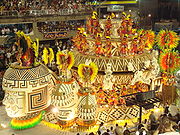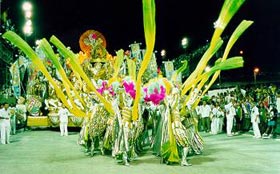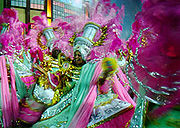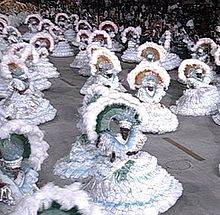
Rio Carnival
Encyclopedia

Festival
A festival or gala is an event, usually and ordinarily staged by a local community, which centers on and celebrates some unique aspect of that community and the Festival....
held before Lent
Lent
In the Christian tradition, Lent is the period of the liturgical year from Ash Wednesday to Easter. The traditional purpose of Lent is the preparation of the believer – through prayer, repentance, almsgiving and self-denial – for the annual commemoration during Holy Week of the Death and...
every year and considered the biggest carnival in the world with two million people per day on the streets. The first festivals of Rio
Rio de Janeiro
Rio de Janeiro , commonly referred to simply as Rio, is the capital city of the State of Rio de Janeiro, the second largest city of Brazil, and the third largest metropolitan area and agglomeration in South America, boasting approximately 6.3 million people within the city proper, making it the 6th...
date back to 1723.
Samba schools


Samba school
A samba school is a club or dancing school. They practice and often perform in huge square-compounds devoted to practicing and exhibiting samba, an African-Brazilian dance. The schools are traditionally associated with a particular neighborhood, often shanty towns...
s. A samba school can either be an actual school or just a collaboration of local neighbors that want to attend carnival. Samba schools include: Uniao de Sonhadores, Mocidade Independente
GRES Mocidade Independente de Padre Miguel
The Grêmio Recreativo Escola de Samba Mocidade Independente de Padre Miguel is a samba school of the city of Rio de Janeiro, being located on Rua Coronel Tamarindo, in the neighborhood of Padre Miguel.- History :...
, Imperio Serrano, Academicos do Salgueiro
GRES Acadêmicos do Salgueiro
Grêmio Recreativo Escola de Samba Acadêmicos do Salgueiro, popularly known simply as Salgueiro is a popular samba school from Rio de Janeiro, Brazil...
, Unidos da Tijuca, and Beija-Flor de Nilopolis.
The purpose of carnival is for samba schools to compete with fellow rival schools; this competition is the climax of the whole carnival festival. Each school chooses a theme to try and portray in their entry. The samba schools work to build the best floats and costumes to represent their themes, and to include the best music they can from their band called the bateria. There are many parts to each school's entry including the six to eight floats and thousands of participants.
There is a special order that every school has to follow with their parade entries. Each school begins with the "comissão de frente", which is the first wing. The "comissão de frente" is made up of ten to fifteen people only, and they are the ones who introduce the school and set the mood. These people have choreographic dances in fancy costumes that usually tell a short story. Following the "comissão de frente" is the first float of the samba school, called "abre-alas".
Some of the important roles include the porta-bandeira and mestre-sala. The porta-bandeira is a very important lady who is in charge of the samba school flag, including making sure to not allow the flag to roll. She is accompanied by the mestre-sala, who is supposed to draw everyone’s attention to "his queen", the porta-bandeira. Floatees, who are also important, are the people who populate the floats
Float (parade)
A float is a decorated platform, either built on a vehicle or towed behind one, which is a component of many festive parades, such as those of Mardi Gras in New Orleans, the Carnival of Viareggio, the Maltese Carnival, the Macy's Thanksgiving Day Parade, the Key West Fantasy Fest parade, the...
, also known as destaques. The floatees have the most luxurious and expensive costumes that can be extremely heavy. Along with all the floatees is one main floatee that is located at the top of each float. The main destaque dances and sings for the entire time that the float is on the runway.
One other aspect that is mandatory is the presence of the ala das baianas. This is a wing of the samba school entry that includes at least 100 females only. These women along with many other people do not ride on the floats as many others do, instead they are passistas, the people who belong to the samba school that do the marching alongside and between the floats.
Street carnival
As the parade is taking place in the SambadromeSambadrome
The Sambadrome Marquês de Sapucaí or simply Sambadrome, is a purpose-built parade area in downtown Rio de Janeiro, Brazil where samba schools parade competitively each year during the Rio Carnival...
and the balls are being held in the Copacabana Palace and beach, many of the carnival participants are at other locations. Street festivals are very common during carnival and are highly populated by the locals. Elegance and extravagance are usually left behind, but music and dancing are still extremely common. Anyone is allowed to participate in the street festivals. Bandas and bondos are very familiar with the street carnival especially because it takes nothing to join in on the fun except to jump in. One of the most well known bandas of Rio is Banda de Ipanema
Banda de Ipanema
Banda de Ipanema is one of the highlights of Rio de Janeiro's street Carnival festivities. The first parade happened in 1965, when Brazil was under a military dictatorship. In 2004 it was declared part of the city's cultural heritage...
. Banda de Ipanema was first created in 1965 and is known as Rio’s most irreverent street band.
Music and dance

The samba is the main dance of Rio Carnival but it is not performed in silence. Music is another major aspect of all parts of carnival. As stated by Samba City, “Samba Carnival Instruments are an important part of Brazil and the Rio de Janeiro Carnevale, sending out the irresistible beats and rhythms making the crowd explode in a colourful dance revolution fantasy fest!” The samba that is found in Rio is batucada
Batucada
Batucada is a substyle of samba and refers to an African influenced Brazilian percussive style, usually performed by an ensemble, known as a Bateria...
, referring to the dance and music being based on percussion instruments. It “is born of a rhythmic necessity that it allows you to sing, to dance, and to parade at the same time.” This is why the batucada style is found in most all of Rio’s street carnivals.
Instruments of carnival
Before the samba gained the percussive style, it was played with flutes and string instruments because percussion was looked upon as corrupt. It was in 1930 that the shift came to allow for percussion instruments. There is an ensemble of drum and percussion players that are led by a man that plays an apitoApito
thumb|right|200px|The Apito or 'Samba' whistle.Apito is the whistle used in samba music and other Brazilian music styles. In samba a special tri-tone samba whistle and common referee whistles are also used. It is important in organizing and conducting the band. The band leader and the section...
, a whistle used to control the music. The apito has three tones but is not very loud, so many leaders prefer to use referee whistles instead.
There are several types of drums within the ensemble including the surdos, caixas, repiniques, and tamborim. The surdo is a wide and deep drum that gives the bass drum foundation sound. The caixas is similar to the snare drum that gains it sound from the thin springs underneath the skin of the drum. Repiniques are just like the caixis except they do not have the sharp snare sound because they are missing the springs. Tamborims make similar sounds to the snare but are actually small cylinders covered with one tight skin.
With the combination of the parade, the balls, and the street carnivals, Rio’s carnival is said to be the greatest show on Earth. As the Rio de Janeiro handbook states, “The Rio carnival is probably the most famous party in the world.”
Dates
The following are the dates of the starting Saturdays. The main carnival processions take place on the Sunday and Monday evenings after these dates :- March 5th 2011
- February 18th 2012
- February 9th 2013
- March 1st 2014
External links
- Carnival in Rio: Crazy, Sexy, Weird - slideshow by Life magazine

